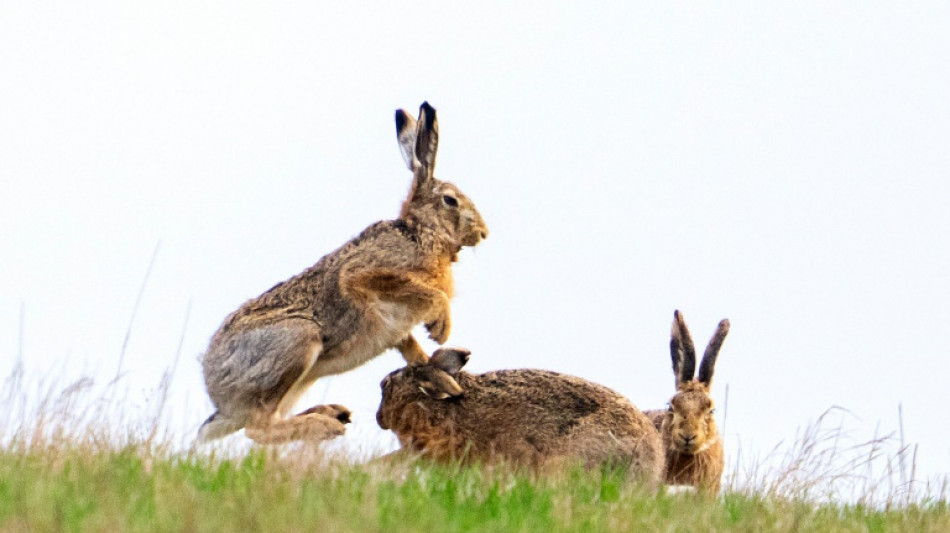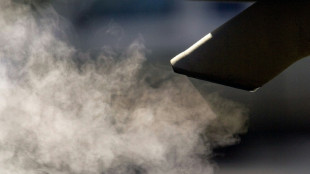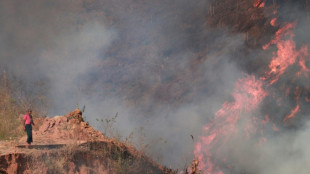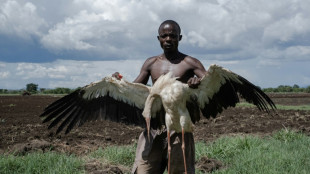
-
 Indian army says new exchange of gunfire with Pakistan
Indian army says new exchange of gunfire with Pakistan
-
Epstein accuser Virginia Giuffre takes own life in Australia: family

-
 Hundreds of buildings damaged, dozens injured in 6.3 Ecuador quake
Hundreds of buildings damaged, dozens injured in 6.3 Ecuador quake
-
India and Pakistan's Kashmir fallout hits economy too

-
 Francis's funeral to be grand farewell to 'pope of the poor'
Francis's funeral to be grand farewell to 'pope of the poor'
-
Pogacar faces defiant Evenepoel at Liege-Bastogne-Liege

-
 Chelsea eye great escape against Barcelona in Women's Champions League
Chelsea eye great escape against Barcelona in Women's Champions League
-
Iran, US to hold new round of high-level nuclear talks

-
 'Energy and effort' pay off for Reds as Blues' woes continue
'Energy and effort' pay off for Reds as Blues' woes continue
-
Albatross and closing birdie lift China's Liu to LPGA Chevron lead

-
 On the horizon? Wave of momentum for high seas treaty
On the horizon? Wave of momentum for high seas treaty
-
Developing countries should fast-track US trade deals: World Bank president

-
 Grizzlies' Morant 'doubtful' for must-win game 4 v Thunder
Grizzlies' Morant 'doubtful' for must-win game 4 v Thunder
-
Trump in Rome for pope funeral in first foreign trip of new term

-
 Trump says Russia-Ukraine deal 'very close' after new Kremlin talks
Trump says Russia-Ukraine deal 'very close' after new Kremlin talks
-
US rookies lead PGA pairs event with McIlroy and Lowry in hunt

-
 Trump tariff promises get a reality check
Trump tariff promises get a reality check
-
Warriors coach Kerr 'relatively optimistic' injured Butler will play game 3

-
 Postecoglou hopes 'Stonecutter's Credo' can inspire Spurs
Postecoglou hopes 'Stonecutter's Credo' can inspire Spurs
-
PSG lose unbeaten Ligue 1 record ahead of Arsenal showdown

-
 Venezuela accuses El Salvador president of 'human trafficking'
Venezuela accuses El Salvador president of 'human trafficking'
-
Own goal takes Sundowns to African final against Pyramids

-
 Scores of buildings damaged, 20 injured in Ecuador quake
Scores of buildings damaged, 20 injured in Ecuador quake
-
US stocks extend rally as market eyes busy calendar next week

-
 Pope's death triggers surge of disinformation he fought against
Pope's death triggers surge of disinformation he fought against
-
Rovanpera takes control of Rally Islas Canarias

-
 Zelensky insists Crimea is Ukrainian as US envoy meets Putin
Zelensky insists Crimea is Ukrainian as US envoy meets Putin
-
Patel and Mendis help Sunrisers beat Kings in Dhoni's 400th T20

-
 Copa del Rey ref statements 'unacceptable': Real Madrid after boycotting final build-up
Copa del Rey ref statements 'unacceptable': Real Madrid after boycotting final build-up
-
Insurance CEO's accused killer pleads not guilty to federal murder charges

-
 FBI arrests Wisconsin judge for shielding undocumented migrant
FBI arrests Wisconsin judge for shielding undocumented migrant
-
Brazil ex-president Collor de Mello jailed for corruption

-
 Zelensky insists Crimea 'belongs' to Ukraine as US envoy meets Putin
Zelensky insists Crimea 'belongs' to Ukraine as US envoy meets Putin
-
Real Madrid boycott Copa del Rey build-up over referee complaints

-
 Trinidad and Tobago votes for parliament, PM, with opposition in lead
Trinidad and Tobago votes for parliament, PM, with opposition in lead
-
IMF chief hails 'constructive' Spring Meetings held under tariff uncertainty

-
 Iran FM Araghchi in Oman ahead of nuclear talks with US
Iran FM Araghchi in Oman ahead of nuclear talks with US
-
Dozens of buildings destroyed, 20 injured in Ecuador quake

-
 Young Barca must 'enjoy' Real Madrid Copa final fight: Flick
Young Barca must 'enjoy' Real Madrid Copa final fight: Flick
-
Pakistan and India border closure separates families

-
 Brazil's Bolsonaro 'stable' after post-surgery setback
Brazil's Bolsonaro 'stable' after post-surgery setback
-
Catholics in secular Cuba hail Francis as 'bridge'

-
 US envoy Witkoff, Putin discuss 'possibility' of direct Russia-Ukraine talks
US envoy Witkoff, Putin discuss 'possibility' of direct Russia-Ukraine talks
-
Community seeks answers after French school knife killing

-
 German prosecutors seek jail terms in VW 'dieselgate' trial
German prosecutors seek jail terms in VW 'dieselgate' trial
-
Sabalenka makes winning start at Madrid Open

-
 EU, US should de-escalate and negotiate trade deal: IMF Europe director
EU, US should de-escalate and negotiate trade deal: IMF Europe director
-
Russia accuses Ukraine of killing general in car bombing

-
 Emery wants FA Cup glory and Champions League berth for Villa
Emery wants FA Cup glory and Champions League berth for Villa
-
Buildings destroyed, one injured in Ecuador quake


Cute but calamitous: Australia labours under rabbit numbers
With their outsized ears and fluffy fur, rabbits are often seen as cute and harmless. Yet the creature is behind one of the globe's most harmful biological invasions, ravaging Australia, whose efforts to limit the problem have tended only to make things worse.
Back in 1859, a mere 24 European breeding rabbits, scientific name Oryctolagus cuniculus, disembarked from England, brought over by Thomas Austin, who enjoyed hunting parties on his Victoria estate.
But 150 years on, and according to a 2022 study by PNAS, a peer reviewed journal of the US National Academy of Sciences, some 200 million rabbit colonisers now roam the land of the kangaroo, devouring vegetation as they go, laying waste to native plant species, causing habitat degradation and threatening the survival of numerous native species.
With as many as seven annual litters -- each with an average of five offspring who reach sexual maturity from the age of 3-4 months -- the rabbit is able to spread its presence very quickly.
From its early years Down Under, the creature benefited from the general absence of predators and its facility to adapt to its new climate.
That enabled it to spread out by some 110 kilometres (65 miles) a year. Within 70 years, it had occupied around 70 percent of Australia's land mass.
That made it "the fastest known invasion by a mammal anywhere in the world," according to a report by Australia's national science agency CSIRO.
- Counting the cost -
The rabbit may look small and placid -- yet it is voracious in the extreme. Herbs, bulbs, seeds, shrubs -- its appetite extends to all kinds of herbaceous plant. This contributes to desertification of the outback, deprives other species of food and also eats away at crops.
The agricultural and horticultural damage wrought by the critters comes in at some 200 million Australian dollars ($130 million) each year, according to the Western Australian ministry for agriculture and food.
As such, for more than a century now, the authorities have been doing all they can to try to limit the damage.
Intensive hunting, traps, bulldozers to destroy burrows, poison or even explosives -- everything has been tried. But the rabbit has resisted and its numbers have progressed.
In 1901, Australia decided to construct an 1,800 kilometre-long (1,118 miles) barrier in a bid to stop the furry creatures proliferating to the country's western agricultural lands.
Yet by the time construction was completed, rabbits had already reached the other side. An extension followed, then another, taking the fence to beyond 3,000 km of barriers and fences. All in vain.
Australia tried plan B -- introducing predators, such as the fox.
The 'cure' proved to be worse than the disease. It turned out the fox preferred to target easier prey such as small marsupials endemic to the country and already threatened with extinction.
- Classic cases -
In the 1950, science was recruited to come to the rescue.
The myxomatosis virus, a disease which causes fatal tumours in rabbits, was introduced into the country. To begin with, success looked to have been achieved, the rabbit population going from 600 million down to 100 million. But it managed to adapt and ended up developing resistance to a virus which gradually became ineffective.
Australia tried a new angle of attack some years later: the Spanish flea, supposed to spread disease among rabbits.
Again, the plan failed. Worse still, the parasite infected other species.
In 1995, a new attempt at eradication followed, via a haemorrhagic fever virus, which ended up worrying the scientific community amid fears it might mutate.
Very effective against rabbits, this highly contagious pathogen can further spread quickly to other countries via mosquitoes. Two years later, it arrived in New Zealand, likewise also labouring under a rabbit invasion.
If Australia thought that might have been a price worth paying, there would soon be disabused.
The stoat, introduced as a predator to the rabbit left deprived as the population dropped, fell back on targeting the kiwi, a bird endemic to the island which became threatened in turn.
Both Australia and New Zealand represent classic cases in terms of what not to do regarding the introduction and management of invasive species, says Elaine Murphy, principal scientist at New Zealand's Department of Conservation and an expert on introduced mammals and the threats to diversity they pose.
While rabbit numbers look to have stabilised under the 300 million mark, the Australian government says it is maintaining research into means of permanently stemming the propagation problem.
D.Cunningha--AMWN



